BRIEFLY
Edited by Rodd Whelpley
ARTS FOR ALL
The Illinois arts road show
Beginning this January, some Illinoisans may be spared
the trek to far off museums, concert halls or theaters.
Instead, the arts may be coming to them.
Illinois Arts Treasures on Tour, a program of the Illinois
Arts Council, will target communities that lack arts institution
of their own and offer them exhibits and performances
in the fields of theater, music, dance, literary arts, media arts
and visual arts. Marketing Director Ann Ridge says the tour
realizes the council's goal "to allow every county and
community in the state to have access to some kind of art."
Twenty-four arts institutions have
submitted exhibit packages for the tour,
and the council has combined them to
form a diverse program.
The Chinese Music Society of North
America, for example, is offering performances of Chinese music on traditional
Chinese instruments. Other institutions offering exhibits include the Elgin
Symphony Orchestra, the Review of
Contemporary Fiction and the Ravinia
Festival Association. Along with the
exhibits and performances, artists will
offer educational activities or workshops.
To help defray the cost of exhibit fees,
communities may apply to the Arts
Council for matching
funds grants.
The Arts Treasures on
Tour is made possible, in
part, by a $3.4 million
increase to the arts
council's budget for fiscal
year 1999. Gov. Jim
Edgar touted the
increase in February as
a way to help smaller
communities "offer the
arts programming and
education opportunities
that every Illinoisan
deserves."
The council earmarked
$600,000 for the tour in
1999 and 2000, though
the council's Eliud
Hernandez says the
agency hopes to
continue the program
indefinitely.
Rosalie Warren
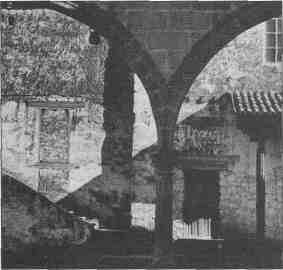
Mexico, by Brett Weston, is one of 42 photographs
selected from the Rock ford Art Museum's photographic
collection for the museum's Arts Treasures on Tour. The
exhibit was put together by three Illinois photographers
and is titled "Parallel Views: Selected Images / Fresh
Interpretations."
Courtesy of the Rockford Art Museum
|
WEB SITE OF THE MONTH Time, arts and the web
As 1998 winds down, the new
millennium is but a year away (if you
accept the "round number" definition). So you may want to ruminate
on Time. The Illinois Humanities
Council has already done that and
made it available on their web site at
www.prairie.org.
From the council's home page,
click on the "Detours" icon to go to
the fall '98 edition of the online magazine. There you will find essays on
the concept of time, from the Big
Bang to the history of clocks. But
that is just the beginning of this pathway to — and for — thinkers. From
the main page, the "Road Scholars"
icon takes you to an extensive list of
speakers who are available to make
presentations on such topics as
women in farming, Illinois authors,
the Underground Railroad and
prehistoric rock art in Illinois.
The site also has an online bookstore, "Ex Libris," that highlights
books about Illinois and by
Illinoisans. Users can order selections
directly through Barnes and Noble
online, and their purchases will benefit the Illinois Humanities Council.
The "Grants Program" icon
points to information about federal-
and state-funded grants for the
humanities, plus application forms.
Harder to find, but well worth the
hunt, are the council's links to other
humanities organizations. Look for
"Site Map" then click on "Links."
There are also links to Illinois state
agencies, museums, libraries, education and media sites, and the state's
colleges and universities. Five links
go to sites dedicated to Lincoln.
The Programs and Events Calendar sections are a bit outdated, but
will be current with the next calendar
year.
As Longfellow said, "Art is long,
and Time is fleeting," so take a side
trip to learn what's happening in the
humanities. Beverley Scobell
|
10 / December 1998 Illinois Issues
CHICAGO VOTES ON IDEOLOGY
As with any election, the story isn't that Chicago voted Democratic, the story is how Democratic Chicago voted,
Statewide, Republicans George Ryan won the governorship and Peter Fitzgerald took a U.S. Senate seat, each
with 51 percent of the vote based on 98.8 percent of the precincts reporting. Election-night returns show that
Democratic U.S. Sen. Carol Moseley-Braun and Democratic gubernatorial candidate Glenn Poshard took Chicago,
but their support seemed to ebb and flow more along socio-political than partisan grounds.
Moseley-Braun's support broke slightly along racial lines. Black wards supported her with 96 percent of their vote, while
her support in white wards fell to 62 percent. Poshard's support broke along the same lines with black and Hispanic wards
giving him stronger support than the white wards. But among all race-based demographics, Moseley-Braun drew more
support than Poshard,who got only 53 percent in white wards. The numbers suggest that political ideology was more of a
factor for voters than race. In the liberal-leaning lake front wards on the city's North Side, for example, Democrats turned away
from Poshard's conservatism. In fact, Ryan beat Poshard in six of eight North Side and Lake front wards. The more liberal
Moseley-Braun carried all eight of these wards.
|
The Chicago vote for U.S. Senate
|
|
Wards
|
'Fitzgerald
|
Moseley-Braun
|
Plurality
|
Moseley-Braun %
|
|
African American
(20 wards)
|
12,214
|
299,454
|
Dem. 287,240
|
96
|
|
Hispanic
(7 wards)
|
7,859
|
32,179
|
Dem. 24,320
|
80
|
|
White
(23 wards)
|
117,893
|
190,216
|
Dem. 72,323
|
62
|
|
Total
|
137,966
|
521,849
|
Dem. 383,883
|
79
|
|
Note: This table is based on unofficial returns as compiled by The Associated Press on election night and does not reflect ballots cast for
third-party candidates.
|
|
The Chicago vote for governor
|
|
Wards
|
Ryan
|
Poshard
|
Plurality
|
Poshard %
|
|
African American
(20 wards)
|
47,997
|
238,923
|
Dem. 190,926
|
83
|
|
Hispanic
(7 wards)
|
11,630
|
26,623
|
Dem. 14,993
|
70
|
|
While
(23 wards)
|
141,479
|
158,950
|
Dem. 17,471
|
53
|
|
Total
|
201,106
|
424,496
|
Dem. 223,390
|
68
|
|
Note: This table is based on unofficial returns as compiled by The Associated Press on election night and does not reflect ballots cast for
third-party candidates.
|
|
Returns for selected Chicago wards
|
|
Lakefront/
North Side
|
Ryan
|
Poshard
|
Plurality
|
Poshard %
|
Moseley-Braun
Plurality %
|
|
32nd-NS
|
6,043
|
5,709
|
Rep. 334
|
49
|
4,454
|
68
|
|
42nd-L
|
10,383
|
6,791
|
Rep. 3,592
|
40
|
3,620
|
60
|
|
43rd-L
|
9,186
|
5,391
|
Rep. 3,795
|
37
|
3,270
|
61
|
|
44th-L
|
7,968
|
5,264
|
Rep. 2,704
|
40
|
5,696
|
70
|
|
46th-L
|
5,432
|
4,844
|
Rep. 588
|
47
|
6,364
|
78
|
|
47th-NS
|
6,216
|
6,039
|
Rep. 177
|
49
|
5,098
|
72
|
|
48th-L
|
4,708
|
6,274
|
Dem. 1,566
|
57
|
6,945
|
79
|
|
49th-L
|
2,834
|
5,301
|
Dem. 2,467
|
65
|
5,983
|
84
|
|
Note: This table is based on unofficial returns as compiled by The Associated Press on election night and does not reflect ballots cast
for third-party candidates.
|
Illinois Issues December 1998 / 11
BRIEFLY
War horses
RARE EQUINE TRAINING VOLUME IS U OF I'S NINE MILLIONTH BOOK
When a library has millions of books, finding one not already on the shelves can be a challenge. But since 1935, the
University of Illinois Library, the largest public university library in the world, has added a rare book to its collection to
celebrate each time it reaches another million texts. The newest rare book is a 1616 German Baroque treatise — two volumes
bound as one with 64 detailed engravings — on the breaking and training of
royal cavalry horses and on the fitting
of their bits and bridles. It is the nine-
millionth book in the university's
library.
The book was written by
Christophorus Lieb, an officer in
charge of the royal horses of Christian
II of Saxony, and his brother Johann
Georg I. Lieb. The rare text — Practica Et Arte di Cavalleria (Practice and
Art of Riding), part one, and Gebissbuch (Bit Book), part two — is actually
a 17th century version of the Pentagon
Papers. According to Mara Wade, a
University of Illinois professor of German literature and culture, the book
shows that the shift in weaponry and
warfare called for horses trained to use
speed, mobility and quick reflexes to
take advantage of riders' new lighter-
weight pistols and swords. The training
exercises — illustrated in the book by
tiny horseshoe "prints," much like
notations for ballet dancers — constitute a form of "war secrets" that was
available "only to the courts of reliable
allies," says Wade. That is why there
were perhaps as few as 50 copies of the book published.
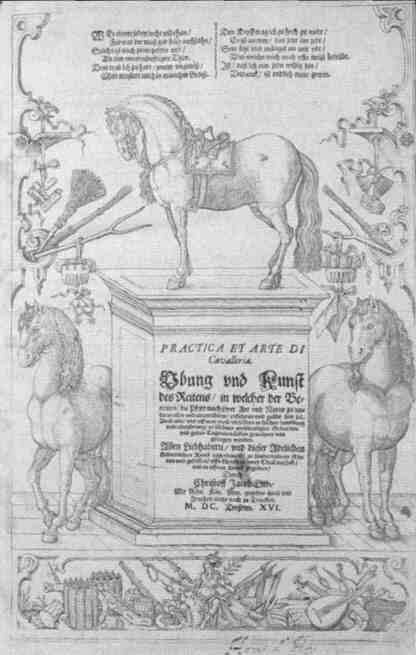
The engraved title page of Practica Et Arte di Cavalleria, published in 1616.
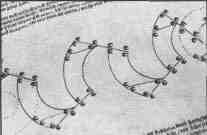
These hoof prints illustrate one of the
training exercises found in Practica Et
Arte di Cavalleria.
12 / December 1998 Illinois Issues
Illinois lags behind the national trend
FINANCE REFORM FINDS FAVOR WITH VOTERS IN OTHER STATES
Supporters call it a trend. When ever voters get the opportunity
to have their say, campaign
finance reform initiatives win.
On November 3, the traditionally
conservative Arizona electorate and the
generally more progressive Massachusetts voters approved "clean elections"
laws. The new laws change the way
elections are financed in those states by
providing public money for candidates
who agree to abide by spending limits,
demonstrate voter support by collecting qualifying contributions from
voters in their district and accept
limited private donations. The Massachusetts law eliminates unlimited "soft
money" transfers from national parties
to state parties. The Arizona law limits
the amount of personal money a
candidate can spend on a campaign.
Maine and Vermont passed similar
legislation in 1996 and 1997, respectively. Maine's law was enacted through
a ballot initiative. Vermont's through a
vote in the state legislature. Meanwhile,
Florida voters on November 3 made
their existing public campaign financing law part of their state constitution.
The victories in this election have
energized grass-roots organizations
working to put similar propositions on
the ballot in other states. According to
Public Campaign, a national nonprofit,
nonpartisan organization working for
campaign finance reform. New Mexico
will introduce reform legislation in
January and Missouri is slated to put
the issue to its voters in 2000.
Illinois is in the "evolutionary
stage" of the reform movement,
according to Cynthia Canary, executive
director of the Illinois Campaign for
Political Reform. Last spring, the
Illinois legislature passed the first
reform measure in 25 years to address
the way candidates raise and spend
money for state office (see Illinois
Issues, July/August, page 7). The
new rules put some restrictions on
candidates who convert campaign
contributions to cash for personal use,
ban certain gifts, establish new disclosure requirements and provide for
ethics commissions. But, Illinois still
has some of the least restrictive laws in
the country: no limits on spending, few
restrictions on fund raising and no plan
for public financing of elections.
Because Illinois' constitution does not
provide for the type of citizen initiative
used in Arizona, Massachusetts and
other states, says Canary, any further
campaign finance reform would have to
be accomplished by the legislature.
Beverley Scobell
Hispanics are a growing political force in Illinois
Over the next 25 years, the Hispanic population in Illinois will increase by 80
percent and may become a potent political influence on state politics. These are
the findings of a report from the United States Hispanic Leadership Institute.
The increase in the Hispanic population outdistances a projected 15 percent
increase in population among African Americans and a decrease of 900,000 among
the white population, according to the report. The Hispanic population in Illinois
currently exceeds one million and is projected to double to 2.3 million by 2025.
The report also points out that voter registration in Chicago, where the majority of Hispanics live, has increased 98 percent since 1982. An estimated 65 percent
of eligible Hispanics, or 162,000 people, are currently registered. That number will
increase to 200,000 by the presidential election in 2000. The report, "Hispanics in
Illinois: Somos El Future," credits redistricting lawsuits, as well as state and federal legislation reducing voter registration restrictions for the increase in numbers
of Hispanic voters since 1984.
Beverley Scobell
Hispanic voter registration in Chicago 1982-2000
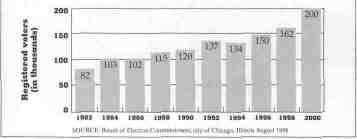
Illinois Issues December 1998 / 13
BRIEFLY
It's a government job
SETTING THE
STAGE AT THE ILLINOIS
STATE MUSEUM
What do theater design and museum
exhibits have in common?
Plenty, according to Joe Hennessy, who
designs displays for the State Museum
and the Department of Natural
Resources.
Hennessy begins by drawing, in his
words, "renderings of what a museum
could look like." And he's currently working on models and documentation for the
museum's first floor renovation project.
After conferring with researchers and
scientists about the items to be showcased, Hennessy sketches possible
displays, then sends those sketches to a
firm in St. Louis, where they are made
into models.
He's also involved with a Department
of Natural Resources' initiative to
improve visitor centers around the state.
And that work takes him to sites across
Illinois. In conjunction
with geologists and
other experts, Hennessy
writes and reviews
scripts for interpretive
video presentations,
then helps edit the
videos.
Recently, Hennessy
was at Giant City
making a film about the
disputed origins of its
rock formations. He has
also researched what a
visitor center at the
Cache River State
Natural Area might look like. If all goes
as planned, a visitor center proposal will
go before the state legislature. Meanwhile,
Hennessy has already completed visitor
center projects at Pere Marquette, Kickapoo and Moraine Hills.
To prepare to become the window
dresser of the state's natural history,
Hennessy got a bachelor's degree in fine
arts, majoring in stage design at the
Goodman School of Theatre in Chicago
— an educational path that might at first
seem incongruous with museum work.
But Lothar Witteborg, former director of
the Field Museum, advised Hennessy to
take that degree. At that time, Hennessy
says, "There wasn't any other way to get
into museum design. People were just
beginning to realize that museum
exhibits could be three dimensional
environments."
Rosalie Warren
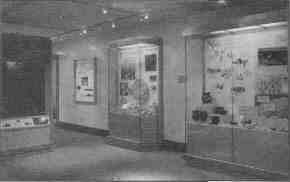
This is the Hennessy-designed exhibit at Pere
Marquette State Park.
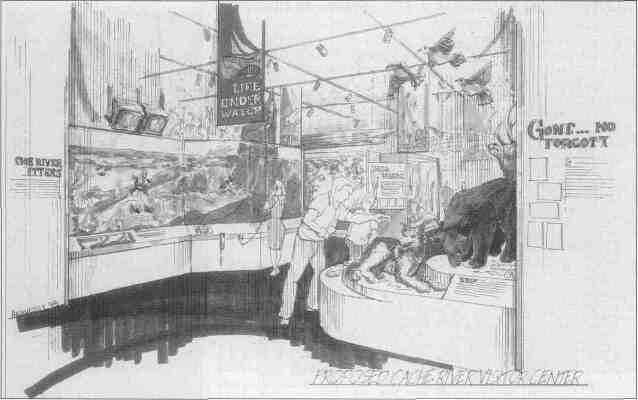
Joe Hennessy's sketch of a proposed visitor center at the Cache River in southern Illinois.
14 / December 1998 Illinois Issues
Pass the bowl
COMMISSION MOVES TO END LUCK.OF-THE.DRAW REDISTRICTING
Gov.-elect George Ryan could
break the infamous crystal
bowl, or at least use it for
punch. In January, a legislative redistricting commission may give him the
chance.
In 1991, after Gov. Jim Thompson
vetoed the Democratic legislature's
redistricting map and the constitutionally mandated eight-member Legislative Redistricting Commission (composed of four Democrats and four
Republicans) failed to produce a compromise, Secretary of State George
Ryan pulled Republican Al Jourdan's
name from the crystal bowl, making
the state party chairman the tie-breaking vote on the commission that
mapped out the state's current legislative districts. Shortly after the bowl was
put away, Ryan, in response to criticism
about "government by lottery,"
appointed a commission to find a better way to redraw the state's legislative districts.
Now, with the decennial redistricting process drawing near, the Ryan-
appointed Redistricting Process Review
Commission is drawing up a set of proposals to present to the legislature.
The 28 members are trying to find a
way to "avoid long, expensive court
battles" that have historically followed
redistricting and "restore the electorate's respect for the process," says
Jeffrey Ladd, chairman of the commission. Among the suggestions the commission is considering are:
• Returning to cumulative voting
and three-member districts in the Illinois House, which would make districts
more difficult to change and put potentially fewer members at political risk.
• Taking the governor out of the
process, so that once the legislature has
reached a compromise, the legislative
district map could not be undone by a
veto.
• Taking coterminous districts —
that is, matching the boundaries of two
house districts with each senate district
— out of the mix, so that one legislative chamber does not have to worry
about the other's map.
• Using the Iowa model of drawing
district maps by a computer that
ignores incumbents and where they
reside, if the legislature fails to draw a
map.
Proponents of change believe that
the current system encourages partisan
entrenchment because history suggests
that the party that draws the legislative
map gains a decade-long political
advantage. Ladd says the bottom line is
that the state needs a process that will
provide the legislature with a greater
incentive for compromise. And the person who asked the commission to find
a better process is now governor.
Beverley Scobell
High-tech
What makes
Champaign-Urbana hot?
With 70 high-tech firms, Champaign-Urbana made Newsweek's list
of 10 world cities that are challenging
Silicon Valley for the lure of entrepreneurs, great jobs and new wealth in the
Information Age.
I The magazine cited the work of
Larry Smarr, an astrophysicist, in setting up the National Center for Super-computing Applications at the University of Illinois in the mid-1980s. The U
I of I now has more supercomputing
power than any other university in the
country. The area is perfect, Newsweek
says, "for researchers and programmers
who are interested in serious
computing."
I The other cities listed were Austin;
Bangalore, India; Boise; Boston; Cambridge, England; Salt Lake City; Seattle;
Tel Aviv; and Washington, D.C. The
story, "The Hottest Tech Cities" by
Steven Levy, appeared in the November
9 issue of the newsweekly.
Ed Wojcicki
Illinois Issues December 1998 / 15





